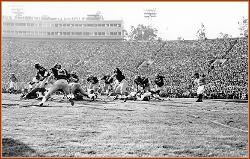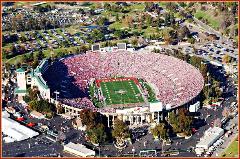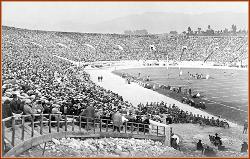



Cisco Field in Fremont, CA
Cisco Field is a proposed baseball stadium in Fremont, California. It would be the new
home of the Oakland Athletics and may open as early as 2010, replacing their current
home at McAfee Coliseum, where the team has resided since their move to California in
1968. This stadium would mark the first time that the A's franchise has received a totally
new stadium to play in since the completion of Shibe Park in 1909.
In April 2006, A's owner Lewis Wolff first took a modified version of his so-called Ballpark
Village proposal to the suburban San Francisco Bay Area city of Fremont where a large
143 acre parcel of land is available just north of Mission Boulevard and south of Auto Mall
Parkway off Interstate 880 and across from Pacific Commons. The land is currently owned
by the city of Fremont and leased to Cisco Systems. The land had been purchased in the
late 90's in anticipation of company growth by Cisco that never occurred due to the dot
com bust. The ballpark village plan had previously been offered up to the city of Oakland.
Development Plan
The plan calls for the 170 acres to be developed into a combination of retail, other
commercial and residential spaces in addition to the construction of a 36,000 seat
baseball only facility. It will be the smallest stadium in Major League Baseball. The planned
development is similar to the Santana Row development in nearby San Jose, California
with the addition of the baseball park. The planned name for the park is Cisco Field as
first announced by the Fremont city council after meeting with Wolff on November 8, 2006.
The stadium will be privately financed primarily from sales of the surrounding "ballpark
village" residential and commercial properties to offset the cost of the stadium. The
earliest the stadium would open is for the 2010 season.
Announcement
A formal press conference to announce the existence of Cisco Field was held on
November 14, 2006. Allan H. "Bud" Selig, commissioner of Major League Baseball and
John Chambers, the CEO of Cisco Systems along with Wolff, were in attendance.
Possible Train
The Capital Corridor and Altamont Commuter Express trains also pass reasonably close
to the proposed ballpark site, although no nearby station exists. The San Jose Mercury
News reported that Wolff has asked the city of Fremont to allow the use of an additional,
unused 40 acre property at the corner of Auto Mall Parkway and the railroad tracks for a
parking lot. This lot might also be a good spot to build a train station. Difficulties involved
with the use of commuter rail include the relatively low number of train sets owned by the
two services and the heavily used section of single-track rail along much of the potential
route to the south as well as along a short distance to the north.
The proposed Caltrain Dumbarton Rail service will pass an existing rail junction just 3.5
miles northwest of the site. This project is currently in the environmental impact report
stage. If this project is completed, Caltrain service to both San Jose and San Francisco
could conceivably be extended to the stadium site via a combination of the Dumbarton
tracks and the existing tracks. Caltrain currently offers service to spectators at AT&T Park,
Bay Meadows, Stanford Stadium, and HP Pavilion.
Bus shuttle service to and from the existing Fremont or Union City BART stations is the
probable short term solution.
The proposed BART Warm Springs Station, slated to be located where S. Grimmer Blvd
crosses the railroad tracks, north of NUMMI plant, may be within the reach of a long
elevated walkway or moving sidewalk. A simple pedestrian bridge over Interstate 880 from
Christy St. to Enterprise St. could serve as a lower cost alternative, along with a potential
bus shuttle from the East side of the bridge to and from the station. Other possibilities of
connecting that future station to the ballpark village include bus shuttles, a monorail, or a
"people-mover".
Deal Not Final - Other Options
Other options being pursued by outside sources ranged from other locations in the city of
Oakland or suburban locations inside Alameda County to moving the team out of the Bay
Area. The most promising of these had been a site in uptown Oakland. In a 2001 study,
HOK Sport had suggested this as the prime site for a ballpark, however plans to build a
park there were cancelled by Mayor Jerry Brown. Brown opted to sell the site to
condominium builder to whom he had ties. The City of Oakland also considered a site
near the Oakland Estuary for a stadium, however, the A's showed no interest in the site
due to lack of public transit access. In addition much of the land had already been sold to
a condominium developer.
San Jose was not an option for the A's since the San Francisco Giants have an
agreement with Major League Baseball that demarks San Jose as within its territory. If the
A's had moved out of the Bay Area, the most likely destinations were Las Vegas,
Sacramento, or Portland, Oregon.














